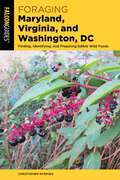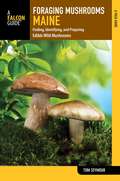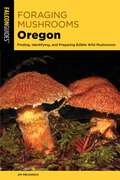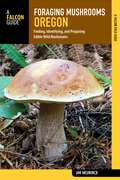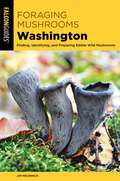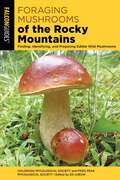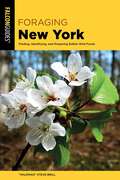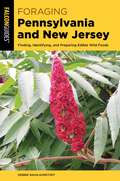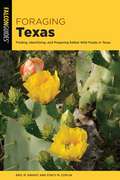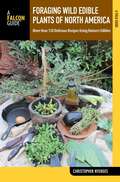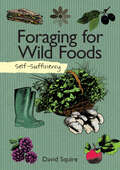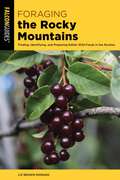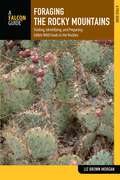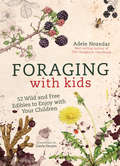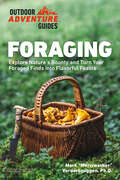- Table View
- List View
Foraging Maryland, Virginia, and Washington, DC: Finding, Identifying, and Preparing Edible Wild Foods (Foraging Series)
by Christopher NyergesThrough the seasons, Maryland, Virginia, and Washington D.C. offer a continually changing list of wild, harvestable treasures. This full-color book guides you to the edible wild foods and healthful herbs of the regions and will help you identify and appreciate the local bounty. Inside you'll find: Detailed descriptions of edible plantsTips on finding, preparing, and using foraged foodsA glossary of botanical termsFull-color photos
Foraging Mushrooms Maine: Finding, Identifying, and Preparing Edible Wild Mushrooms (Foraging Series)
by Tom SeymourDetailed descriptions of edible mushrooms; tips on finding, preparing, and using mushrooms; a glossary of botanical terms; color photos. Use Foraging Mushrooms as a field guide or as a delightful armchair read. No matter what you&’re looking for, be it the curative Heal-All or a snack, this guide will enhance your next backpacking trip or easy stroll around the garden, and may just provide some new favorites for your dinner table.
Foraging Mushrooms Oregon: Finding, Identifying, and Preparing Edible Wild Mushrooms (Foraging Mushrooms)
by Jim MeuninckDetailed descriptions of edible mushrooms; tips on finding, preparing, and using mushrooms; a glossary of botanical terms; color photos. Use Foraging Mushrooms as a field guide or as a delightful armchair read. No matter what you&’re looking for, be it the curative Heal-All or a snack, this guide will enhance your next backpacking trip or easy stroll around the garden, and may just provide some new favorites for your dinner table.
Foraging Mushrooms Oregon: Finding, Identifying, and Preparing Edible Wild Mushrooms (Foraging Series)
by Jim MeuninckDetailed descriptions of edible mushrooms; tips on finding, preparing, and using mushrooms; a glossary of botanical terms; color photos. Use Foraging Mushrooms as a field guide or as a delightful armchair read. No matter what you&’re looking for, be it the curative Heal-All or a snack, this guide will enhance your next backpacking trip or easy stroll around the garden, and may just provide some new favorites for your dinner table.
Foraging Mushrooms Washington: Finding, Identifying, and Preparing Edible Wild Mushrooms (Foraging Series)
by Jim MeuninckDetailed descriptions of edible mushrooms; tips on finding, preparing, and using mushrooms; a glossary of botanical terms; color photos. Use Foraging Mushrooms Washington as a field guide or as a delightful armchair read. No matter what you&’re looking for, be it the curative Heal-All or a snack, this guide will enhance your next backpacking trip or easy stroll around the garden, and may just provide some new favorites for your dinner table.
Foraging Mushrooms of the Rocky Mountains: Finding, Identifying, and Preparing Edible Wild Mushrooms (Foraging Mushrooms)
by Colorado Mycological Society Pikes Peak Mycological SocietyUse Foraging Mushrooms of the Rocky Mountains as a field guide or as a delightful armchair read. No matter what you&’re looking for, be it the curative heal-all or a snack, this guide will enhance your next backpacking trip or easy stroll in the woods, and may just provide some new favorites for your dinner table.Foraging Mushrooms of the Rocky Mountains provides detailed descriptions of edible mushrooms that grow in the Rocky Mountain region of the United States into British Columbia. Look inside for tips on finding, preparing, and using mushrooms, a glossary of botanical terms, and color photos.
Foraging New England: Edible Wild Food and Medicinal Plants from Maine to the Adirondacks to Long Island Sound (Foraging Series)
by Tom SeymourFrom beach peas to serviceberries, hen of the woods to Indian cucumber, ostrich ferns to sea rocket, Foraging New England guides the reader to the edible wild foods and healthful herbs of the Northeast. Helpfully organized by environmental zone, the book is an authoritative guide for nature lovers, outdoorsmen, and gastronomes.
Foraging New England: Edible Wild Food and Medicinal Plants from Maine to the Adirondacks to Long Island Sound (Foraging Series)
by Tom SeymourFrom beach peas to serviceberries, hen of the woods to Indian cucumber, ostrich ferns to sea rocket, Foraging New England guides the reader to the edible wild foods and healthful herbs of the Northeast. Helpfully organized by environmental zone, the book is an authoritative guide for nature lovers, outdoorsmen, and gastronomes.
Foraging New York: Finding, Identifying, and Preparing Edible Wild Foods (Foraging Series)
by "Wildman" Steve BrillFrom beach peas to serviceberries, hen of the woods to Indian cucumber, ostrich ferns to sea rocket, this guide uncovers the edible wild foods and healthful herbs of New York. Helpfully organized by environmental zone, the book is an authoritative guide for nature lovers, outdoorsmen, and gastronomes.
Foraging New York: Finding, Identifying, and Preparing Edible Wild Foods (Foraging Series)
by "Wildman" Steve BrillFrom beach peas to serviceberries, cattails to burdock root, and ostrich ferns to sea rocket, Foraging New York uncovers the edible wild foods and healthful herbs of the Empire State. Helpfully organized by food group and season, this book is an authoritative guide for nature lovers, outdoor enthusiasts, and gastronomes. Inside you'll find: • Species ranging from herbs to trees • Expert advice on identifying, preparing, freezing, drying, storing, and cooking wild edibles • Tools, techniques, and foraging etiquette • Recipes to prepare at home and on the trail
Foraging Oregon: Finding, Identifying, and Preparing Edible Wild Foods in Oregon (Foraging Series)
by Christopher NyergesFrom wild carrot to serviceberries, pineapple weed to watercress, lamb&’s quarter to sea rocket, Foraging Oregon uncovers the edible wild foods and healthful herbs of the Beaver State. Fully revised and updated, and helpfully organized by plant families, the book is an authoritative guide for nature lovers, outdoorsmen, and gastronomes.This guide also includes:Elderberry SauceMia&’s Chickweed SoupFireweed JellyShiyo&’s Garden SaladVegetable ChipsStinging Nettles Hot SauceWild BreadNorthwest Brickle
Foraging Pennsylvania and New Jersey: Finding, Identifying, and Preparing Edible Wild Foods
by Debbie Naha-KoretzkyFrom cattails to wild garlic, this guide uncovers the edible wild foods and healthful herbs of Pennsylvania and New Jersey. Written for people who want to know more about foraging, including those who are absolute beginners and perhaps don&’t even know where to start, this book provides clear photos and easy to follow instructions for plant identification. Readers will learn all about safely recognizing, respecting, and utilizing wild plants.Inside you'll find:Detailed descriptions of 70 edible plantsTips on finding, preparing, and using foraged foods70 recipesA glossary of botanical termsFull-color photos
Foraging Texas: Finding, Identifying, and Preparing Edible Wild Foods in Texas
by Eric M. Knight Eric M. Knight and Stacy M. CoplinThe diverse geography of Texas overflows with edible plant species. From elderberry to amaranth and dandelion to cactus, Foraging Texas guides you to 92 edible wild foods and healthful herbs of the state. This valuable reference guide will help you identify and appreciate the wild bounty of the Lone Star State.Foraging Texas provides all of the information you need about wild foods in the state:Detailed descriptions and full-color photos of edible plants Tips on finding, preparing, and using foraged foodsRecipes suitable for the trail and at homeBotanical terms and diagrams complete with an illustrated bibliographyDistribution maps for every plant
Foraging Washington: Finding, Identifying, and Preparing Edible Wild Foods (Foraging Series)
by Christopher NyergesThis valuable reference guide will help you identify and appreciate the continually changing list of wild, harvestable treasures of Washington.Inside you'll find: detailed descriptions of edible plants and animals; tips on finding, preparing, and using foraged foods; a glossary of botanical terms; full-color photos. Use Foraging Washington as a field guide or as a delightful armchair read. No matter what you're looking for, be it the curative Heal-All or tasty Purslane, this guide will enhance your next backpacking trip or easy stroll around the garden, and may just provide some new favorites for your dinner table.
Foraging Washington: Finding, Identifying, and Preparing Edible Wild Foods (Foraging Series)
by Christopher NyergesFrom beach peas to serviceberries, hen of the woods to Indian cucumber, ostrich ferns to sea rocket, this guide uncovers the edible wild foods and healthful herbs of Washington. Helpfully organized by environmental zone, the book is an authoritative guide for nature lovers, outdoorsmen, and gastronomes.
Foraging Wild Edible Plants of North America: More than 150 Delicious Recipes Using Nature's Edibles
by Christopher NyergesEdible wild plants are nature&’s natural food source, growing along roadsides, sprouting in backyards, and blooming in country fields. North America&’s diverse geography overflows with edible plant species. From alyssum to watercress, chicory to purslane, Foraging Wild Plants of North America provides everything you need to know about the most commonly found wild greens with over 200 mouth-watering recipes. This full-color field and feast guide with images to the most common edible wild plants is the ideal companion for hikers, campers, and anyone who enjoys eating the good food of the earth. Look inside to find recipes such as:Stirfry AmaranthYellow Pollen PancakesChickweed DeluxeNettle SoupRoot Coffee Earth BreadCattail StewFennel CrunchPrickly Pear Ice Cream
Foraging Wild Edible Plants of North America: More than 150 Delicious Recipes Using Nature's Edibles (Foraging Series)
by Christopher NyergesEdible wild plants are nature&’s natural food source, growing along roadsides, sprouting in backyards, and blooming in country fields. North America&’s diverse geography overflows with edible plant species. From alyssum to watercress, chicory to purslane, Foraging Wild Plants of North America provides everything you need to know about the most commonly found wild greens with over 200 mouth-watering recipes. Fully revised and updated, this full-color field and feast guide with images to the most common edible wild plants is the ideal companion for hikers, campers, and anyone who enjoys eating the good food of the earth. Look inside to find recipes such as:Stirfry AmaranthYellow Pollen PancakesChickweed DeluxeNettle SoupRoot Coffee Earth BreadCattail StewFennel CrunchPrickly Pear Ice Cream
Foraging for Survival: Edible Wild Plants of North America
by Mykel Hawke Douglas BoudreauWhether you&’re a hiker taking a walk through your local wilderness, or a chef looking for new ingredients to incorporate in your dishes, Foraging for Survival is the book for you. As consumerism and a meat-heavy, processed diet become the norm and the world&’s population continues to grow at an exponential rate, more and more people are looking toward a more sustainable path for food. Authors Douglas Boudreau and Mykel Hawke believe that the future of food lies in the wild foods of times spanning back to before the mass-agriculture system of today. People have become distanced from the very systems that provide their food, and younger generations are increasingly unable to identify even the trees in their backyards. In response, Boudreau and Hawke have provided a compendium of wild edible plants in North America. Foraging for Survival is a comprehensive breakdown of different plant species from bearded lichen to taro, and from all over the United States. There are also tips for growing local native plants in the backyard to facilitate learning and enhance table fare at home. Other information you&’ll find inside: A list of different types of edible wild plantsForaging techniquesBugs and other grubs that can be consumedWarning signs of poisonous plantsAnd much more! Start eating wild today with Foraging for Survival!
Foraging for Wild Foods (Self-Sufficiency)
by David SquireWith delightful illustrations and fascinating facts aimed at young readers, this children&’s book explores the natural world of riverbanks. Have you ever wondered how and why beavers build their dams, how otters live, or how frogs come to be? Now you can find out! This charming picture book teaches young children what it&’s like to be an animal living on and in the water. With each turn of the page, this volume reveals dozens of adorable illustrations, educational captions, and vocabulary words. From beavers and otters to snakes, frogs, newts, and more, children will love learning all about these busy aquatic animals and the amazing lives they live! This is a fixed-format ebook, which preserves the design and layout of the original print book
Foraging the Ozarks: Finding, Identifying, and Preparing Edible Wild Foods in the Ozarks
by Bo BrownThe Ozark Mountains in Missouri and Arkansas have had a long history of foraging since indigenous tribes such as the Osage, Quapaw, and Kickapoo sporadically inhabited the area and utilized the rich natural resources. Settlers from the Appalachians came later and survived on what they could find, trap, and hunt. Foraging remains a major activity among the Ozarks&’ outdoor community, supported in large part by established local restaurateurs and other buyers of wild herbs, berries, and nuts.Foraging the Ozarks, written by local wilderness expert Bo Brown, highlights about a hundred commonly found edibles in the Interior Highlands, from ubiquitous herbs to endemic species. With sidebars, recipes, helpful tips, and toxin warnings throughout, Foraging the Ozarks is the only guidebook the Ozark outdoor enthusiast will need to pick it, cook it, and eat it.
Foraging the Rocky Mountains: Finding, Identifying, And Preparing Edible Wild Foods In The Rockies (Foraging Series)
by Liz Brown MorganThe Rocky Mountain region's diverse geography overflows with edible plant species. From salsify to pearly everlasting, currants to pine nuts, Foraging the Rocky Mountains guides you to 85 edible wild foods and healthful herbs of the region. This valuable reference guide will help you identify and appreciate the wild bounty of the Rocky Mountain states. This guide also includes::detailed descriptions of edible plants and animalstips on finding, preparing, and using foraged foodsrecipes suitable for the trail and at homedetailed, full-color photosa glossary of botanical terms
Foraging the Rocky Mountains: Finding, Identifying, and Preparing Edible Wild Foods in the Rockies (Foraging Series)
by Liz Brown MorganThe Rocky Mountain region's diverse geography overflows with edible plant species. From salsify to pearly everlasting, currants to pine nuts, Foraging the Rocky Mountains guides you to 85 edible wild foods and healthful herbs of the region. This valuable reference guide will help you identify and appreciate the wild bounty of the Rocky Mountain states. This guide also includes::detailed descriptions of edible plants and animalstips on finding, preparing, and using foraged foodsrecipes suitable for the trail and at homedetailed, full-color photosa glossary of botanical terms
Foraging with Kids: 52 Wild and Free Edibles to Enjoy with Your Children
by Adele NozedarA fun, informative and practical introduction to safely foraging with kids, from the UK's bestselling foraging author.In today’s world of increasingly sedentary lifestyles and a growing detachment from the food that we eat, it has never been more important to encourage children to put down their screens, get outside and engage with the natural world around them. Foraging with Kids is a fun, practical book for parents to work through with their children that encourages families to interact with their environment and gain knowledge and practical understanding of the natural world through exploration and play. The projects are based around 50 easy-to-identify plants that are abundant in parks, forests and hedgerows worldwide, making the challenge of discovering functional flora just as achievable to those who live in the city as in the countryside. Once they have foraged their plants, children will be amazed by the diverse practical uses that they can set them to; from making soap from conkers or setting a delicious egg-free custard with plantain, to stopping minor cuts from bleeding with hedge woundwort. Children will take great pride in seeing their gatherings forming part of the family meal and parents will be amazed at how even the most vegetable-averse child will develop an enthusiastic appetite for a meal that they have contributed to. Illustrated throughout with beautiful hand drawings and with essential information on plant facts and identification, as well as a diverse range of engaging, practical projects that the whole family will want to get involved with, this is the perfect book for anyone who wants the children under their care to get outside, connect with nature and have a lot of fun in the process.
Foraging: Discover Free Food from Fields, Streets, Gardens and the Coast
by Paul Chambers&“A useful and practical field guide&” to finding delicious, indigenous edibles—full of color photos and including a forager&’s calendar (The Countryman). Long before there were convenient supermarkets, foraging for edible plants was as essential to survival as hunting and farming. For today&’s forager, it&’s a fun and practically free way to eat fresh and get to know your local environment. In Foraging, naturalist author Paul Chambers gives you the knowledge and knowhow you need to start going on your own foraging adventures. Focused on the British Isles, this comprehensive guide includes lists of indigenous edible plants, arranged alphabetically and by region. A full range of environments are covered, from the fields and forests of the countryside to suburban gardens, city streets, and even the coast. Chambers offers practical tips for identifying, collecting, preparing, and preserving forageables, as well each plants&’ historical, cultural, and medicinal meanings and uses. Packed with helpful illustrations and trivia, this volume is the result of years of experience and a passion for naturalism, and shares more than one hundred plants suitable for eating.
Foraging: Explore Nature's Bounty and Turn Your Foraged Finds Into Flavorful Feasts (Outdoor Adventure Guide)
by Mark VorderbruggenFind edible plants anywhere in North America!Foraged delicacies have become the latest foodie obsession. Wild edibles collected by professional foragers are proliferating on the plates of top-tier restaurants because they offer novel and ultra-fresh sensations for the tongue, and they frequently taste more flavorful than farmed foods. For people seeking new food experiences and wanting to forage for themselves, Idiot&’s Guides: Foraging shows how to find wild edibles and when and how to harvest them. Includes over 30 tasty recipes that describe how to prepare these wild foods.- Includes common plants all across North America.- Covers positive plant identification.- Multiple large, full-color photos identify each plant (including the mature plant, how it looks at various stages of growth, and how it looks at the right stage of growth for harvesting).- Each entry gives facts on the plant's habitat, physical properties, which parts are edible, harvesting sustainability, preparation, storage, and poisonous look-alikes.-More than 30 delicious recipes.-Includes range maps and charts that list plants by habitat and by season.
